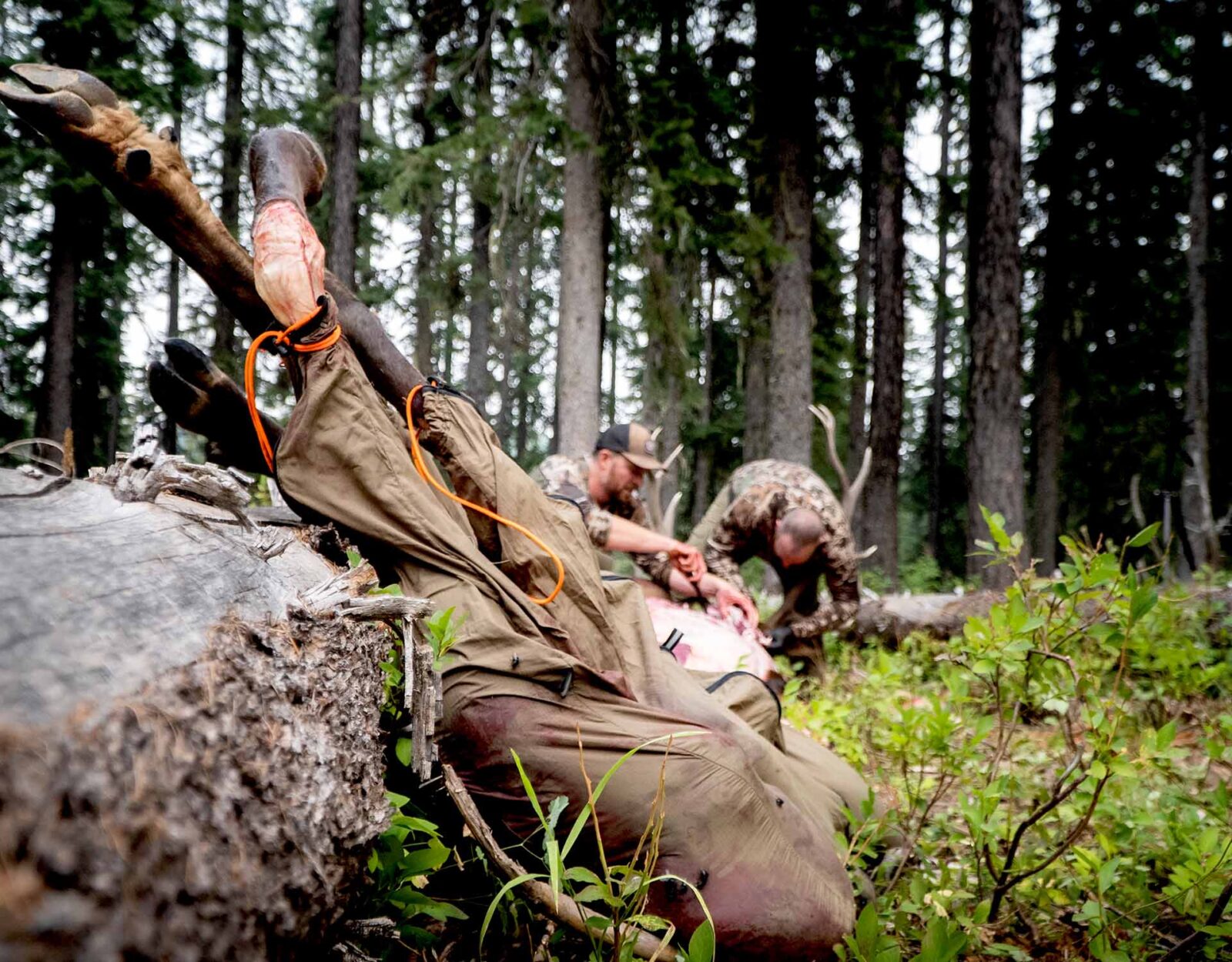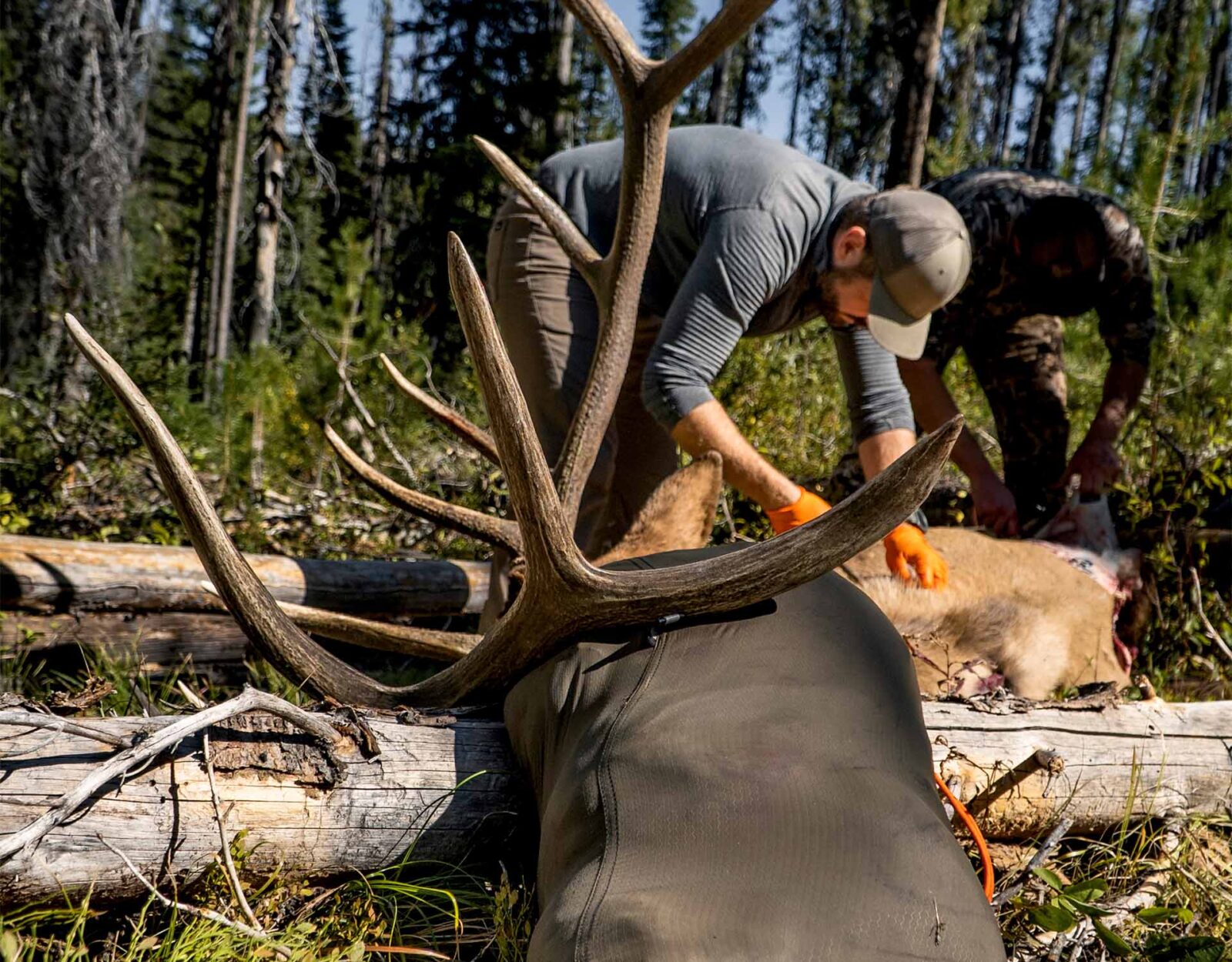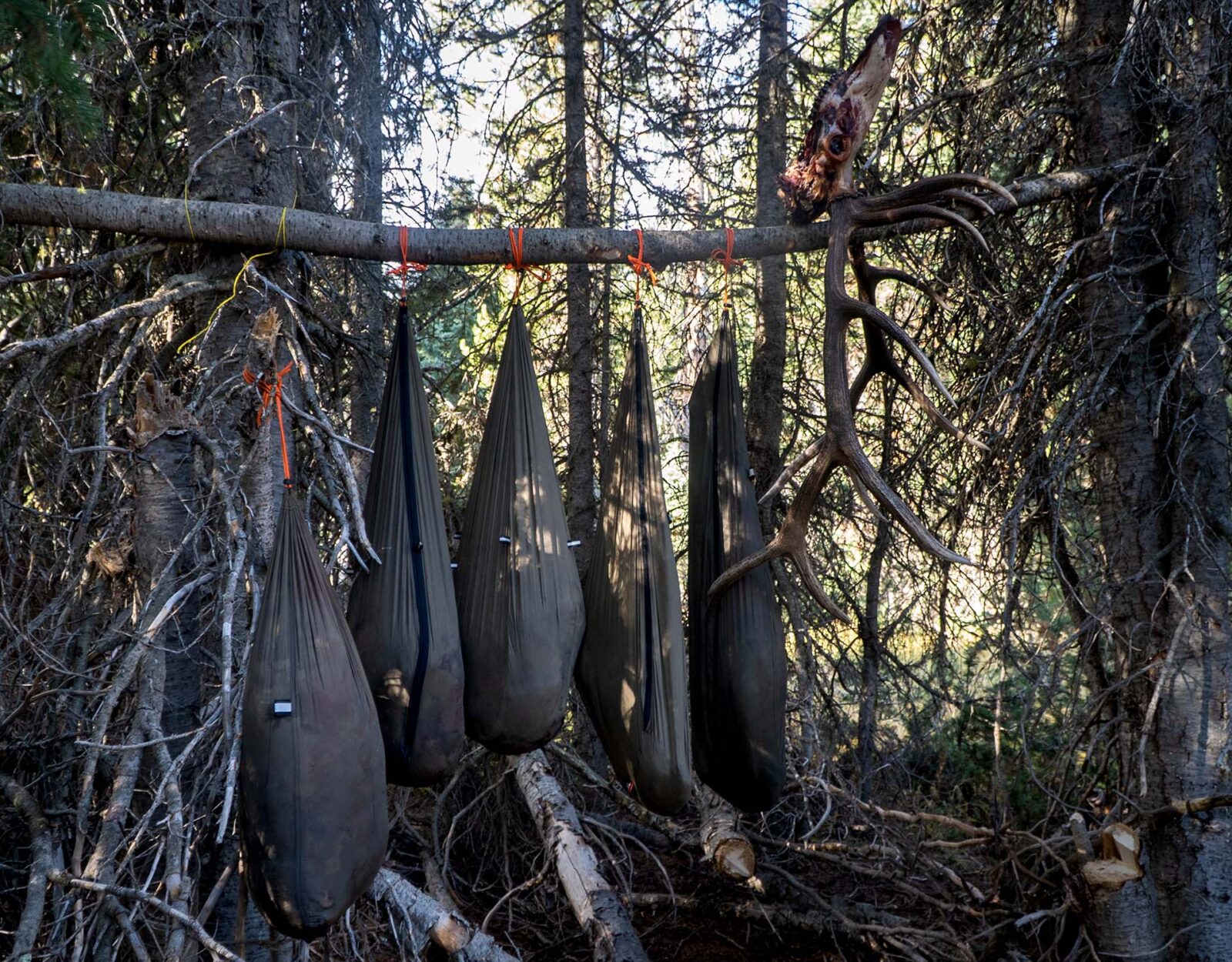Many elk are shot in the backcountry or without a means of getting the entire carcass into a truck, so knowing how to properly quarter an elk for packing out is important. Moreover, having a gutless method of field dressing makes for a cleaner, simpler process where you don’t have to open the body cavity or deal with a messy gut pile.
Below we outline all the tools and details for quartering an elk with the gutless method, and our friend Remi Warren shows us how he uses it to pack out a cow elk on one of his recent hunts.
P.s. We’re using elk as our example here, but you can use the gutless method on any big game animal.

What Is the Gutless Method and Why Use It?
There are several ways of field dressing and quartering big game. If you’re bringing an animal straight to a processor you may just need to remove the organs and deliver the animal with the hide still attached.
Or you might butcher the animal yourself and need to remove the guts to keep the meat from spoiling and to make it easier to drag out of the woods.
The gutless method is especially useful when you need to get a large animal back to the truck and you don’t need to save the hide or the body. The gutless method is also a clean way to get the quarters off for a pack-out. Depending on the scenario, you can choose to keep the meat on the leg bones or de-bone them in the field for the lightest load possible.

Essential Tools for the Gutless Method
There is some essential gear to use for the gutless elk method of field dressing. The most basic “kill kit” includes:
- Knife + blade replacements or sharpener
- Latex gloves (consider the 8mm heavy-duty black nitrile gloves with texturing for extra grip)
- Game bags
- Dry bags/garbage bags (useful for keeping blood out of your internal frame pack)
- Paracord (useful if you need to hang game bags in bear country)
- Folding saw (optional but useful)
Field Dressing Elk: Step-by-Step
Your elk is down and now it’s time to get to work. Follow along as Remi Warren gives a quick demonstration of the gutless method, then review the steps below.
How To Quarter an Elk Using the Gutless Method
Here’s a step-by-step guide for quartering an elk. You’ll do all these steps while the animal is lying on its side. Once finished on one side, flip the animal over and repeat:
Position the elk
Try to position the elk so the legs are downhill to any degree possible. If the animal’s back is uphill it will make the work easier.
Make the first cut
Inserting a sharp knife as the base of the back of the skull, cut along the animal’s spine all the way to where the tail meets the body. Cutting from head to tail allows you to cut in the direction of its hair, making your cut more visible and less likely to cut the hairs in the process.
Cut along the back leg
Cut along the back of the back leg up to the cut you made along the spine.
Cut along the front leg
Cut along the back of the front leg up to the cut you made along the spine.
Remove the hide
Working carefully, skin and pull the hide down and away from the body and away from the front and hind quarters. You’ll note how the front quarter and neck hide will be pulled toward the front of the animal, while the back quarter and rib sections of hide will be pulled down toward the belly.
Once the hide is peeled away from the carcass, you can begin removing the quarters, backstrap, and tenderloin.
Remove the hind quarter
To remove the hind quarter, start at the top of the quarter near the spine. Cut all the way through until you expose the hip bone. After cutting as much of the hind quarter away from the body from the top side as possible, raise the leg up, either resting it on your shoulder while you’re kneeling or having someone hold it for you, and get ready to work the underside.
Work the underside of the hind quarter slowly to ensure you don’t nick the gut pouch or get too close to the anus. The underside of the hip joint will become exposed as you work closer to it. Run your knife around the hip joint and start twisting the leg clockwise to work the joint loose. To make any final cuts to free the quarter, you may need to lift the hind quarter straight up and pull away while cutting.
Remove the front quarter
Now you’re ready to remove the front quarter. The front quarter is easier because there is no joint in the front shoulder. The front leg is only attached by muscle and sinew.
Again working from the outside top down, begin cutting along the seams of the muscle. Once you’ve worked the top side as much as possible, raise the leg and start cutting from the underside until the front quarter is free from the body.
Remove the lower legs
Before putting front or hind quarters in a game bag, it’s best to remove the lower parts of the legs. At the first joint between the quarter and the leg (the “knee joint” for lack of a better term), cut around the leg right at the joint. You shouldn’t need a saw for this. Keep cutting around the leg and through any ligaments until the leg comes free.
Remove the backstrap
After you remove both quarters, cut along the side of the spine from the base of the skull toward the tail to begin removing the backstrap. You’ll find that your knife will only be able to cut down three or four inches (on an elk) because it will run up against the top of the ribs.
After making this cut all the way down, you’ll cut perpendicular to the spine (again from skull to tail) to detach the backstrap. It’s almost like you’re cutting a “V” to remove the backstrap.
Remove the tenderloin
Most of the time you can access the tenderloin, which sits nearly atop the hind quarter but under the spine. Again, use extreme caution not to puncture the gut sack. In fact, you may be able to use your hand to feel for the tenderloin and tear it away from the spine.
Elk tenderloins vary in size, but a one-pound elk tenderloin is typically 13 inches long, 5.5 inches wide, and 0.5 inches thick.
Remove the rib meat
With the gutless method, it’s difficult to cut away the rib bones, plus the ribs are big and may be difficult to pack out. In this case, most hunters carefully cut away the strips of meat between each rib (search for “rib roll” videos).

Additional Considerations
Keep Meat Cool: No matter what field dressing method you’re using, remember: Meat spoils quickly in heat. If you can find shade to hang the quarters in while you work, that will help, or hang it above water in cooler air.
Be Bear Aware: Elk country is often bear country. Stay vigilant looking out for black bears and grizzly bears. If you have to make multiple trips for a pack out, hang the remaining meat away from the carcass and in a place you can visually see before fully approaching so you don’t startle a bear when you get back.
Know Your Wanton Waste Regulations: These rules differ from state to state. Take as much as you can and certainly as much as you are legally required to.
Closing
The gutless elk method will take practice but is worthwhile to master. It can be efficient, clean, and save you some weight on heavy pack-outs.